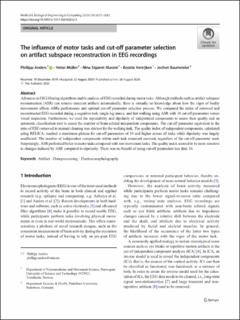| dc.contributor.author | Anders, Phillipp | |
| dc.contributor.author | Müller, Helen Martha | |
| dc.contributor.author | Skjæret-Maroni, Nina | |
| dc.contributor.author | Vereijken, Beatrix | |
| dc.contributor.author | Baumeister, Jochen | |
| dc.date.accessioned | 2021-02-02T07:48:28Z | |
| dc.date.available | 2021-02-02T07:48:28Z | |
| dc.date.created | 2020-12-03T09:31:12Z | |
| dc.date.issued | 2020 | |
| dc.identifier.issn | 0140-0118 | |
| dc.identifier.uri | https://hdl.handle.net/11250/2725700 | |
| dc.description.abstract | Advances in EEG filtering algorithms enable analysis of EEG recorded during motor tasks. Although methods such as artifact subspace reconstruction (ASR) can remove transient artifacts automatically, there is virtually no knowledge about how the vigor of bodily movements affects ASRs performance and optimal cut-off parameter selection process. We compared the ratios of removed and reconstructed EEG recorded during a cognitive task, single-leg stance, and fast walking using ASR with 10 cut-off parameters versus visual inspection. Furthermore, we used the repeatability and dipolarity of independent components to assess their quality and an automatic classification tool to assess the number of brain-related independent components. The cut-off parameter equivalent to the ratio of EEG removed in manual cleaning was strictest for the walking task. The quality index of independent components, calculated using RELICA, reached a maximum plateau for cut-off parameters of 10 and higher across all tasks while dipolarity was largely unaffected. The number of independent components within each task remained constant, regardless of the cut-off parameter used. Surprisingly, ASR performed better in motor tasks compared with non-movement tasks. The quality index seemed to be more sensitive to changes induced by ASR compared to dipolarity. There was no benefit of using cut-off parameters less than 10. | en_US |
| dc.language.iso | eng | en_US |
| dc.publisher | Springer | en_US |
| dc.rights | Navngivelse 4.0 Internasjonal | * |
| dc.rights.uri | http://creativecommons.org/licenses/by/4.0/deed.no | * |
| dc.title | The influence of motor tasks and cut-off parameter selection on artifact subspace reconstruction in EEG recordings | en_US |
| dc.type | Peer reviewed | en_US |
| dc.type | Journal article | en_US |
| dc.description.version | publishedVersion | en_US |
| dc.source.volume | 1 | en_US |
| dc.source.journal | Medical and Biological Engineering and Computing | en_US |
| dc.source.issue | 11 | en_US |
| dc.identifier.doi | 10.1007/s11517-020-02252-3 | |
| dc.identifier.cristin | 1855626 | |
| dc.description.localcode | Open Access This article is licensed under a Creative Commons Attribution 4.0 International License, which permits use, sharing, adaptation, distribution and reproduction in any medium or format, as long as you give appropriate credit to the original author(s) and the source, provide a link to the Creative Commons licence, and indicate if changes were made. The images or other third party material in this article are included in the article's Creative Commons licence, unless indicated otherwise in a credit line to the material. If material is not included in the article's Creative Commons licence and your intended use is not permitted by statutory regulation or exceeds the permitted use, you will need to obtain permission directly from the copyright holder. To view a copy of this licence, visit http://creativecommons.org/licenses/by/4.0/. | en_US |
| cristin.ispublished | true | |
| cristin.fulltext | original | |
| cristin.qualitycode | 1 | |

